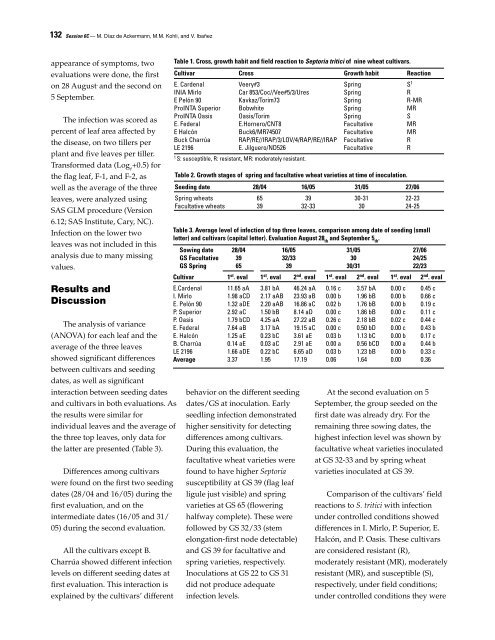Septoria and Stagonospora Diseases of Cereals - CIMMYT ...
Septoria and Stagonospora Diseases of Cereals - CIMMYT ...
Septoria and Stagonospora Diseases of Cereals - CIMMYT ...
Create successful ePaper yourself
Turn your PDF publications into a flip-book with our unique Google optimized e-Paper software.
Session 6C — M. Díaz de Ackermann, M.M. Kohli, <strong>and</strong> V. Ibañez<br />
132<br />
appearance <strong>of</strong> symptoms, two<br />
evaluations were done, the first<br />
on 28 August . <strong>and</strong> the second on<br />
5 September.<br />
The infection was scored as<br />
percent <strong>of</strong> leaf area affected by<br />
the disease, on two tillers per<br />
plant <strong>and</strong> five leaves per tiller.<br />
Transformed data (Loge +0.5) for<br />
the flag leaf, F-1, <strong>and</strong> F-2, as<br />
well as the average <strong>of</strong> the three<br />
leaves, were analyzed using<br />
SAS GLM procedure (Version<br />
6.12; SAS Institute, Cary, NC).<br />
Infection on the lower two<br />
leaves was not included in this<br />
analysis due to many missing<br />
values.<br />
Results <strong>and</strong><br />
Discussion<br />
The analysis <strong>of</strong> variance<br />
(ANOVA) for each leaf <strong>and</strong> the<br />
average <strong>of</strong> the three leaves<br />
showed significant differences<br />
between cultivars <strong>and</strong> seeding<br />
dates, as well as significant<br />
interaction between seeding dates<br />
<strong>and</strong> cultivars in both evaluations. As<br />
the results were similar for<br />
individual leaves <strong>and</strong> the average <strong>of</strong><br />
the three top leaves, only data for<br />
the latter are presented (Table 3).<br />
Differences among cultivars<br />
were found on the first two seeding<br />
dates (28/04 <strong>and</strong> 16/05) during the<br />
first evaluation, <strong>and</strong> on the<br />
intermediate dates (16/05 <strong>and</strong> 31/<br />
05) during the second evaluation.<br />
All the cultivars except B.<br />
Charrúa showed different infection<br />
levels on different seeding dates at<br />
first evaluation. This interaction is<br />
explained by the cultivars’ different<br />
Table 1. Cross, growth habit <strong>and</strong> field reaction to <strong>Septoria</strong> tritici <strong>of</strong> nine wheat cultivars.<br />
Cultivar Cross Growth habit Reaction<br />
E. Cardenal Veery#3 Spring S1 INIA Mirlo Car 853/Coc//Vee#5/3/Ures Spring R<br />
E Pelón 90 Kavkaz/Torim73 Spring R-MR<br />
ProINTA Superior Bobwhite Spring MR<br />
ProINTA Oasis Oasis/Torim Spring S<br />
E. Federal E.Hornero/CNT8 Facultative MR<br />
E Halcón Buck6/MR74507 Facultative MR<br />
Buck Charrúa RAP/RE//IRAP/3/LOV/4/RAP/RE//IRAP Facultative R<br />
LE 2196 E. Jilguero/ND526 Facultative R<br />
1 S: susceptible, R: resistant, MR: moderately resistant.<br />
Table 2. Growth stages <strong>of</strong> spring <strong>and</strong> facultative wheat varieties at time <strong>of</strong> inoculation.<br />
Seeding date 28/04 16/05 31/05 27/06<br />
Spring wheats 65 39 30-31 22-23<br />
Facultative wheats 39 32-33 30 24-25<br />
Table 3. Average level <strong>of</strong> infection <strong>of</strong> top three leaves, comparison among date <strong>of</strong> seeding (small<br />
letter) <strong>and</strong> cultivars (capital letter). Evaluation August 28th <strong>and</strong> September 5th .<br />
Sowing date 28/04 16/05 31/05 27/06<br />
GS Facultative 39 32/33 30 24/25<br />
GS Spring 65 39 30/31 22/23<br />
Cultivar 1st . eval 1st . eval 2nd . eval 1st . eval 2nd . eval 1st . eval 2nd . eval<br />
E.Cardenal 11.65 aA 3.81 bA 46.24 aA 0.16 c 3.57 bA 0.00 c 0.45 c<br />
I. Mirlo 1.98 aCD 2.17 aAB 23.93 aB 0.00 b 1.96 bB 0.00 b 0.66 c<br />
E. Pelón 90 1.32 aDE 2.20 aAB 16.86 aC 0.02 b 1.76 bB 0.00 b 0.19 c<br />
P. Superior 2.92 aC 1.50 bB 8.14 aD 0.00 c 1.86 bB 0.00 c 0.11 c<br />
P. Oasis 1.79 bCD 4.25 aA 27.22 aB 0.26 c 2.18 bB 0.02 c 0.44 c<br />
E. Federal 7.64 aB 3.17 bA 19.15 aC 0.00 c 0.50 bD 0.00 c 0.43 b<br />
E. Halcón 1.25 aE 0.23 bC 3.61 aE 0.03 b 1.13 bC 0.00 b 0.17 c<br />
B. Charrúa 0.14 aE 0.03 aC 2.91 aE 0.00 a 0.56 bCD 0.00 a 0.44 b<br />
LE 2196 1.66 aDE 0.22 bC 6.65 aD 0.03 b 1.23 bB 0.00 b 0.33 c<br />
Average 3.37 1.95 17.19 0.06 1.64 0.00 0.36<br />
behavior on the different seeding<br />
dates/GS at inoculation. Early<br />
seedling infection demonstrated<br />
higher sensitivity for detecting<br />
differences among cultivars.<br />
During this evaluation, the<br />
facultative wheat varieties were<br />
found to have higher <strong>Septoria</strong><br />
susceptibility at GS 39 (flag leaf<br />
ligule just visible) <strong>and</strong> spring<br />
varieties at GS 65 (flowering<br />
halfway complete). These were<br />
followed by GS 32/33 (stem<br />
elongation-first node detectable)<br />
<strong>and</strong> GS 39 for facultative <strong>and</strong><br />
spring varieties, respectively.<br />
Inoculations at GS 22 to GS 31<br />
did not produce adequate<br />
infection levels.<br />
At the second evaluation on 5<br />
September, the group seeded on the<br />
first date was already dry. For the<br />
remaining three sowing dates, the<br />
highest infection level was shown by<br />
facultative wheat varieties inoculated<br />
at GS 32-33 <strong>and</strong> by spring wheat<br />
varieties inoculated at GS 39.<br />
Comparison <strong>of</strong> the cultivars’ field<br />
reactions to S. tritici with infection<br />
under controlled conditions showed<br />
differences in I. Mirlo, P. Superior, E.<br />
Halcón, <strong>and</strong> P. Oasis. These cultivars<br />
are considered resistant (R),<br />
moderately resistant (MR), moderately<br />
resistant (MR), <strong>and</strong> susceptible (S),<br />
respectively, under field conditions;<br />
under controlled conditions they were









